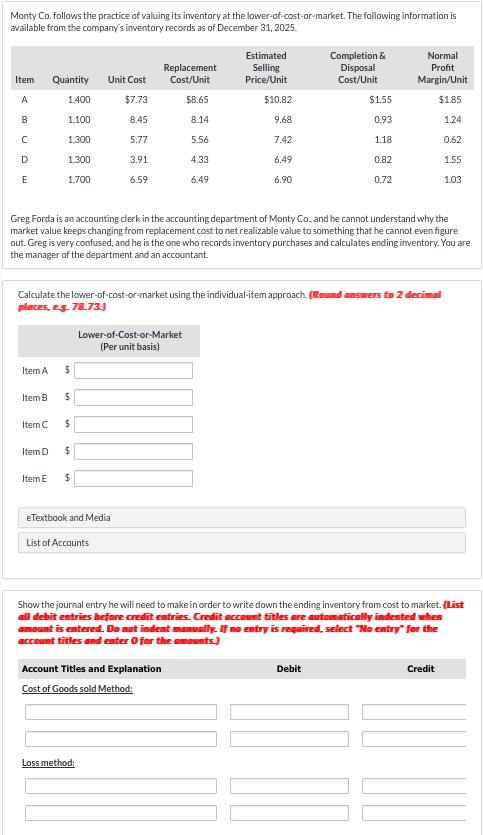Monty Co. follows the practice of valuing its inventory at the lower-of-cost-or-market. The following information is available from the company's inventory records as of December 31, 2025. Estimated Item Quantity Unit Cost Replacement Cost/Unit Selling Price/Unit Completion & Disposal Cost/Unit Normal Profit Margin/Unit A 1,400 $7.73 $8.65 $10.82 $1.55 $1.85 B 1,100 8.45 8.14 9.68 0.93 1.24 C 1,300 5.77 5.56 7.42 1.18 0.62 D 1,300 3.91 4.33 6.49 0.82 1.55 E 1,700 6.59 6.49 6.90 0.72 1.03 Greg Forda is an accounting clerk in the accounting department of Monty Co., and he cannot understand why the market value keeps changing from replacement cost to net realizable value to something that he cannot even figure out. Greg is very confused, and he is the one who records inventory purchases and calculates ending inventory. You are the manager of the department and an accountant. Calculate the lower-of-cost-or-market using the individual-item approach. (Round answers to 2 decimal places, e.g. 78.73.) Lower-of-Cost-or-Market (Per unit basis) Item A $ Item B $ Item C $ Item D $ Item E $ eTextbook and Media List of Accounts Show the journal entry he will need to make in order to write down the ending inventory from cost to market. (List all debit entries before credit entries. Credit account titles are automatically indented when amount is entered. Do not indent manually. If no entry is required, select "No entry" for the account titles and enter 0 for the amounts.) Account Titles and Explanation Cost of Goods sold Method: Debit Credit Loss method:
Monty Co. follows the practice of valuing its inventory at the lower-of-cost-or-market. The following information is available from the company's inventory records as of December 31, 2025. Estimated Item Quantity Unit Cost Replacement Cost/Unit Selling Price/Unit Completion & Disposal Cost/Unit Normal Profit Margin/Unit A 1,400 $7.73 $8.65 $10.82 $1.55 $1.85 B 1,100 8.45 8.14 9.68 0.93 1.24 C 1,300 5.77 5.56 7.42 1.18 0.62 D 1,300 3.91 4.33 6.49 0.82 1.55 E 1,700 6.59 6.49 6.90 0.72 1.03 Greg Forda is an accounting clerk in the accounting department of Monty Co., and he cannot understand why the market value keeps changing from replacement cost to net realizable value to something that he cannot even figure out. Greg is very confused, and he is the one who records inventory purchases and calculates ending inventory. You are the manager of the department and an accountant. Calculate the lower-of-cost-or-market using the individual-item approach. (Round answers to 2 decimal places, e.g. 78.73.) Lower-of-Cost-or-Market (Per unit basis) Item A $ Item B $ Item C $ Item D $ Item E $ eTextbook and Media List of Accounts Show the journal entry he will need to make in order to write down the ending inventory from cost to market. (List all debit entries before credit entries. Credit account titles are automatically indented when amount is entered. Do not indent manually. If no entry is required, select "No entry" for the account titles and enter 0 for the amounts.) Account Titles and Explanation Cost of Goods sold Method: Debit Credit Loss method:
Cornerstones of Financial Accounting
4th Edition
ISBN:9781337690881
Author:Jay Rich, Jeff Jones
Publisher:Jay Rich, Jeff Jones
Chapter6: Cost Of Goods Sold And Inventory
Section: Chapter Questions
Problem 69BPSB
Related questions
Question

Transcribed Image Text:Monty Co. follows the practice of valuing its inventory at the lower-of-cost-or-market. The following information is
available from the company's inventory records as of December 31, 2025.
Estimated
Item
Quantity
Unit Cost
Replacement
Cost/Unit
Selling
Price/Unit
Completion &
Disposal
Cost/Unit
Normal
Profit
Margin/Unit
A
1,400
$7.73
$8.65
$10.82
$1.55
$1.85
B
1,100
8.45
8.14
9.68
0.93
1.24
C
1,300
5.77
5.56
7.42
1.18
0.62
D
1,300
3.91
4.33
6.49
0.82
1.55
E
1,700
6.59
6.49
6.90
0.72
1.03
Greg Forda is an accounting clerk in the accounting department of Monty Co., and he cannot understand why the
market value keeps changing from replacement cost to net realizable value to something that he cannot even figure
out. Greg is very confused, and he is the one who records inventory purchases and calculates ending inventory. You are
the manager of the department and an accountant.
Calculate the lower-of-cost-or-market using the individual-item approach. (Round answers to 2 decimal
places, e.g. 78.73.)
Lower-of-Cost-or-Market
(Per unit basis)
Item A
$
Item B
$
Item C
$
Item D
$
Item E
$
eTextbook and Media
List of Accounts
Show the journal entry he will need to make in order to write down the ending inventory from cost to market. (List
all debit entries before credit entries. Credit account titles are automatically indented when
amount is entered. Do not indent manually. If no entry is required, select "No entry" for the
account titles and enter 0 for the amounts.)
Account Titles and Explanation
Cost of Goods sold Method:
Debit
Credit
Loss method:
Expert Solution
This question has been solved!
Explore an expertly crafted, step-by-step solution for a thorough understanding of key concepts.
Step by step
Solved in 2 steps

Recommended textbooks for you

Cornerstones of Financial Accounting
Accounting
ISBN:
9781337690881
Author:
Jay Rich, Jeff Jones
Publisher:
Cengage Learning

Intermediate Accounting: Reporting And Analysis
Accounting
ISBN:
9781337788281
Author:
James M. Wahlen, Jefferson P. Jones, Donald Pagach
Publisher:
Cengage Learning

Financial Accounting
Accounting
ISBN:
9781337272124
Author:
Carl Warren, James M. Reeve, Jonathan Duchac
Publisher:
Cengage Learning

Cornerstones of Financial Accounting
Accounting
ISBN:
9781337690881
Author:
Jay Rich, Jeff Jones
Publisher:
Cengage Learning

Intermediate Accounting: Reporting And Analysis
Accounting
ISBN:
9781337788281
Author:
James M. Wahlen, Jefferson P. Jones, Donald Pagach
Publisher:
Cengage Learning

Financial Accounting
Accounting
ISBN:
9781337272124
Author:
Carl Warren, James M. Reeve, Jonathan Duchac
Publisher:
Cengage Learning

Financial And Managerial Accounting
Accounting
ISBN:
9781337902663
Author:
WARREN, Carl S.
Publisher:
Cengage Learning,

Principles of Accounting Volume 1
Accounting
ISBN:
9781947172685
Author:
OpenStax
Publisher:
OpenStax College

Survey of Accounting (Accounting I)
Accounting
ISBN:
9781305961883
Author:
Carl Warren
Publisher:
Cengage Learning